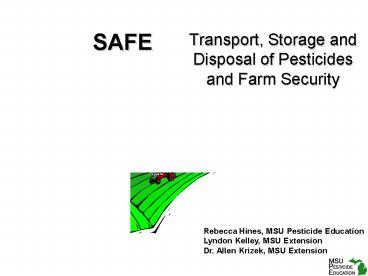SAFE - PowerPoint PPT Presentation
1 / 21
Title:
SAFE
Description:
Safest way back of a truck or pickup. Never in passenger ... Keep spill kit in vehicle (shovel, absorbent material and containers). Unloading Pesticides ... – PowerPoint PPT presentation
Number of Views:27
Avg rating:3.0/5.0
Title: SAFE
1
SAFE
- Transport, Storage and Disposal of Pesticides and
Farm Security
Rebecca Hines, MSU Pesticide Education Lyndon
Kelley, MSU Extension Dr. Allen Krizek, MSU
Extension
2
Why the concern?
- Prevent
- pesticide poisonings
- environmental contamination
- Compliance with the Law
3
Transporting Pesticides
- Safest way back of a truck or pickup.
- Never in passenger compartment!
- Nonporous truck beds.
- Truck in good operating
- condition.
- Secure all containers to
- prevent load shifts.
4
Loading Pesticides for Transport
- Wear appropriate gloves.
- Carry clean PPE in passenger compartment of
vehicle. - Inspect containers before loading.
- Handle containers carefully.
- Secure all containers to prevent load shifts.
- Keep spill kit in vehicle (shovel, absorbent
material and containers).
5
Unloading Pesticides
- Never leave pesticides unattended!
- You are legally responsible
- if people are accidentally
- poisoned from pesticides left
- unattended in your vehicle.
- Inspect vehicle to make sure
- nothing leaked or spilled.
6
Pesticide Storage Location
- 150 ft. from wells (800 ft. for dairy farms or
farms with hired employees). - 200 ft. from surface water.
- Consider wind direction and what is downwind from
storage site. - Easily accessible for delivery, pickup and
emergency vehicles. - Local zoning, building and fire codes.
7
Pesticide Storage Facility
- Separate structure for fire concerns
- Drainage into secondary containment
Fire-resistant structure - Sealed floor
- Non-absorbing shelving
- Pesticide storage sign
WARNING PESTICIDES FIRE WILL CAUSE TOXIC
FUMES No Smoking
8
Pesticide Storage Facility Designing Facilities
for Pesticide Storage
- MWPS-37 Designing Facilities for Pesticide and
Fertilizer Containment, available from MSU Ag
Engineering Dept.
- E-2335 On Farm Agrichemical Storage and
Handling, available from local MSU Extension
office.
9
Pesticide Storage Facility
- Follow the pesticide label.
- Cool, dry, well-ventilated area
- Avoid temperature extremes.
- Always store pesticides in original containers
with label intact.
10
Pesticide Storage
- LOCK IT UP
- Limit access to keys.
- Inspect storage routinely during off-season.
- Check certification of users.
- Clearly post storage areas.
- Use secondary containment.
- Have PPE, spill kit available.
- Avoid stock-piling.
- TAKE INVENTORY.
11
Pesticide Spills
- 5 Cs
- Caution Beware of danger.
- Control the spill to prevent further spillage.
- Contain the spill.
- Cleanup the spill.
- Comply with reporting requirements.
12
Pesticide Spills
- Michigan Department of Agricultures
- Agriculture Pollution Emergency Hotline
- 1-800-405-0101
Practical assistance with the cleanup of
pesticide, fertilizer and manure spills.
13
Disposal of Excess Pesticide
- Small amounts apply to label approved site
being careful not to exceed maximum application
rate. - Michigan Clean Sweep (contact your local MGSP
technician). - Inventory your pesticides and purchase only what
you need then no need to worry about disposal
of excess product.
14
Disposal of Pesticide Containers
- Refillable
- Return to supplier as soon as possible.
- Non-refillable
- Rinse immediately after use.
- Pressure rinse or triple-rinse.
- Add rinse solution to sprayer tank.
- Utilize the pesticide container recycling program
sponsored by the MGSP and MABA.
15
Farm Security
A 50 pound box of Accent herbicide is worth
26,000.
16
Record-keeping
- Inventory of products
- chemical/trade name
- product type
- EPA number
- amount on site
- Inventory of equipment
- brand/description
- serial numbers
17
Know your...
employees suppliers
customers
emergency responders
neighbors
18
Reporting
- trespassers
- thefts
- unusual activity
- suspicious people
19
Planning
- Keep a list of emergency numbers.
- Have a written emergency plan.
- Share the plan with employees.
MSUE Emergency Preparedness Web
Site http//www.msue.msu.edu/msue/emp/
20
Developing a Farm Security Plan (based on Hazard
Analysis Critical Control Point (HACCP))
1) Identify hazards and determine risks. 2)
Institute measures to reduce these hazards. 3)
Determine critical points in your operation. 4)
Develop monitoring procedures at each point. 5)
Develop ways to correct problems or failures if
critical points are compromised. 6) Test your
program periodically.
21
For more information contact
Your local MSU Extension office, MSUE Bulletin
E-2784, SAFE Transport, Storage and Disposal of
Pesticides
MSU Pesticide Safety and Education
Program http//www.pested.msu.edu
Your local Michigan Groundwater Stewardship
Program technician

